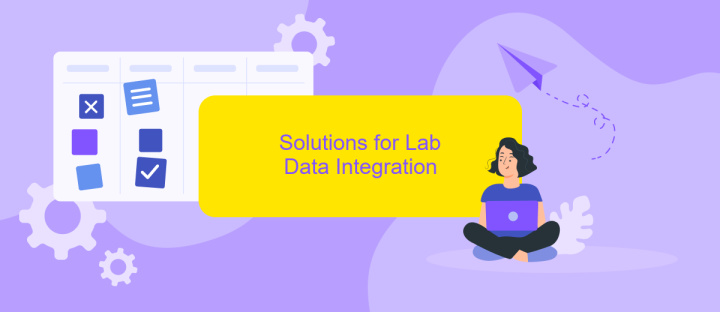Lab Data Integration
In the fast-evolving landscape of scientific research, the integration of lab data has become paramount. Efficient lab data integration not only streamlines workflows but also enhances data accuracy and accessibility. This article explores the critical aspects and benefits of integrating lab data, offering insights into the latest technologies and best practices that drive innovation and efficiency in research environments.
Introduction
Lab Data Integration is a crucial component in modern laboratory environments, enabling seamless data flow between various systems and instruments. This integration ensures that data is accurately captured, stored, and analyzed, leading to improved efficiency and reliability in laboratory operations.
- Automated data transfer
- Real-time data access
- Enhanced data accuracy
- Streamlined workflows
One of the leading services facilitating lab data integration is ApiX-Drive. This platform offers robust solutions for connecting various lab instruments and software, allowing for automated data synchronization. By leveraging ApiX-Drive, laboratories can significantly reduce manual data entry errors, ensure real-time data availability, and optimize their overall workflow. The result is a more efficient and reliable laboratory environment, capable of meeting the demands of modern scientific research and diagnostics.
Data Integration Challenges

Integrating lab data from various sources presents multiple challenges, primarily due to the heterogeneity of data formats and systems. Laboratories often use different software for data collection, storage, and analysis, leading to inconsistencies and difficulties in data harmonization. Ensuring data accuracy and consistency requires robust data validation and transformation processes, which can be both time-consuming and resource-intensive. Additionally, data security and compliance with regulatory standards add another layer of complexity to the integration process.
Another significant challenge is the need for real-time data integration to support timely decision-making. Traditional methods of data integration, which rely on manual processes, are often inadequate for handling large volumes of data efficiently. Services like ApiX-Drive can help mitigate these issues by automating data integration workflows. ApiX-Drive allows seamless connection between various lab systems and applications, ensuring that data is consistently updated and easily accessible. This automation not only reduces the risk of human error but also enhances the overall efficiency of lab operations, making it easier to maintain data integrity and compliance.
Solutions for Lab Data Integration

Integrating lab data efficiently is crucial for enhancing research productivity and ensuring data accuracy. To achieve seamless lab data integration, it is essential to adopt robust solutions that cater to the specific needs of laboratories.
- Utilize middleware platforms like ApiX-Drive to automate data transfer between different lab systems and databases.
- Implement standardized data formats and protocols to ensure compatibility and reduce the risk of data loss during integration.
- Adopt cloud-based solutions for real-time data access and collaboration among researchers and lab technicians.
- Ensure robust data security measures are in place to protect sensitive lab information during and after integration.
By leveraging these solutions, laboratories can streamline their data workflows, enhance collaboration, and improve overall efficiency. Services like ApiX-Drive play a pivotal role in simplifying the integration process, allowing labs to focus more on research and less on data management challenges.
Benefits of Lab Data Integration

Lab data integration offers numerous advantages that can significantly enhance the efficiency and accuracy of laboratory operations. By seamlessly integrating various data sources, labs can streamline workflows, reduce manual data entry, and minimize errors.
One of the primary benefits is the improved data accessibility. Integrated systems allow for real-time data access, enabling lab personnel to make informed decisions quickly. This is particularly crucial in research and clinical settings where timely information can impact outcomes.
- Enhanced data accuracy and consistency
- Reduced manual data entry and associated errors
- Real-time data access and decision-making
- Streamlined workflows and improved efficiency
Services like ApiX-Drive can facilitate lab data integration by providing user-friendly tools to connect various lab instruments and software. With customizable workflows and automated data syncing, ApiX-Drive ensures that labs can focus on their core tasks while maintaining data integrity and compliance.
Future of Lab Data Integration
The future of lab data integration is set to be revolutionized by advancements in automation and artificial intelligence. As laboratories continue to generate vast amounts of data, the need for seamless integration across various platforms becomes paramount. Emerging technologies will enable real-time data sharing, reducing manual entry errors and enhancing overall efficiency. Moreover, the adoption of standardized data formats will facilitate smoother interoperability between different systems, paving the way for more collaborative research and faster scientific discoveries.
One notable development in this area is the rise of integration platforms like ApiX-Drive, which simplify the process of connecting disparate data sources. These platforms offer user-friendly interfaces and powerful automation tools, allowing laboratories to streamline their workflows without needing extensive technical expertise. By leveraging such services, labs can ensure that their data is consistently accurate and readily accessible, ultimately driving innovation and improving outcomes in scientific research. As technology continues to evolve, the potential for more sophisticated and integrated lab data solutions will only grow, promising a future where data-driven insights are more easily attainable than ever before.
FAQ
What is Lab Data Integration?
Why is Lab Data Integration important?
How can I automate Lab Data Integration?
What are the challenges in Lab Data Integration?
How do I get started with Lab Data Integration?
Do you want to achieve your goals in business, career and life faster and better? Do it with ApiX-Drive – a tool that will remove a significant part of the routine from workflows and free up additional time to achieve your goals. Test the capabilities of Apix-Drive for free – see for yourself the effectiveness of the tool.

